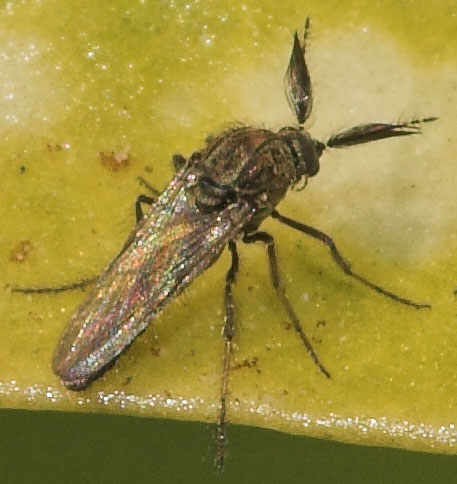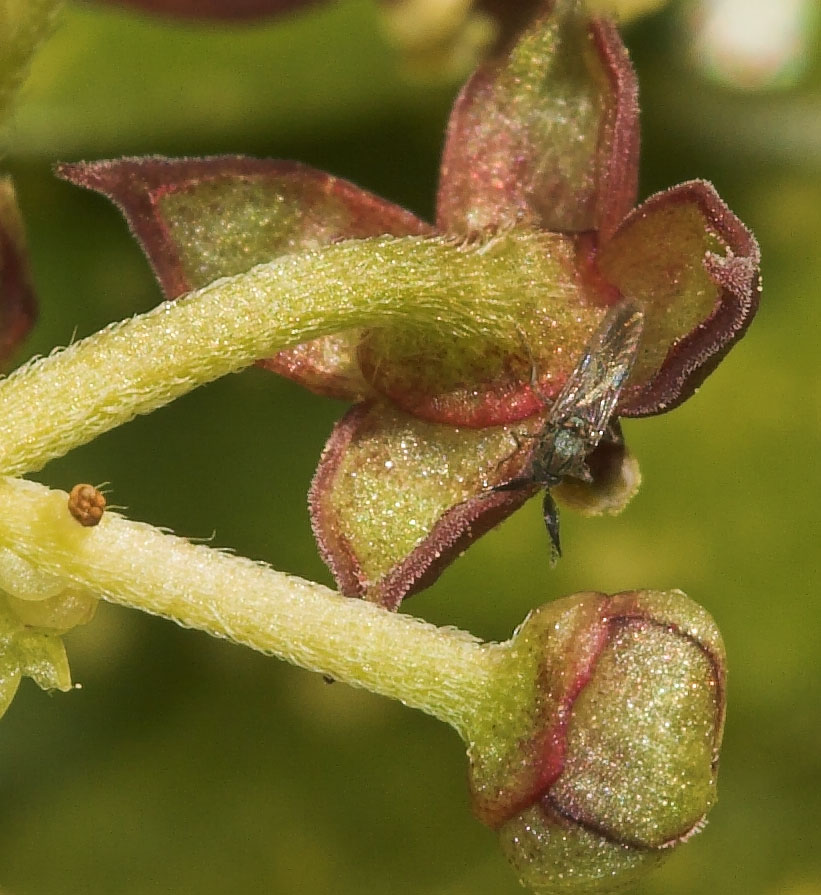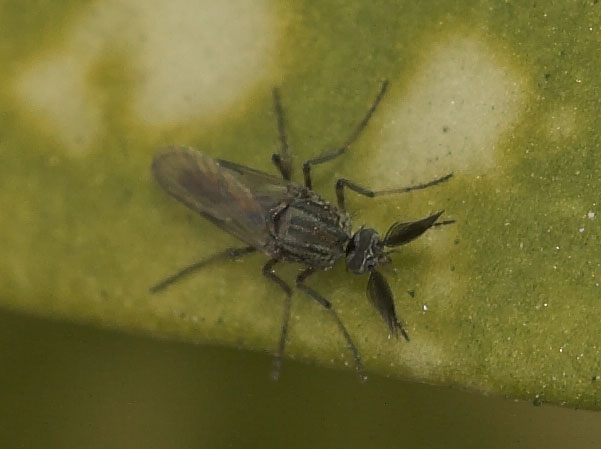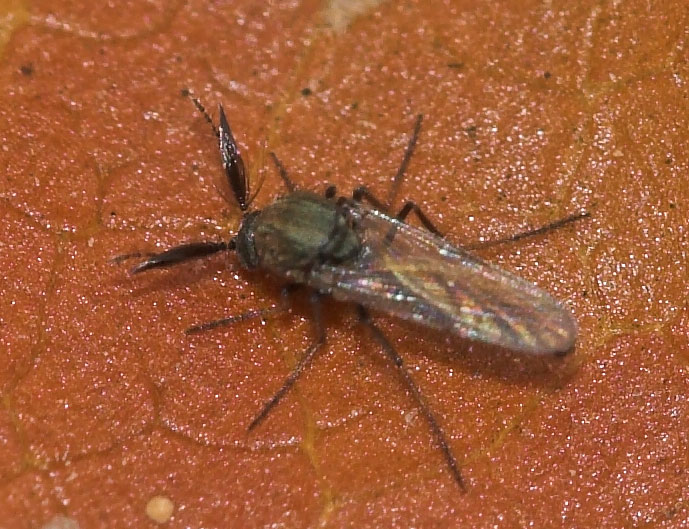Diptera.info :: Identification queries :: Diptera (adults)
|
Little fly with splendid antennas
|
|
| pierred |
Posted on 10-04-2006 19:47
|
|
Member Location: Paris (France) Posts: 1484 Joined: 21.04.05 |
Hello, Found yesterday this beautiful little fly with splendid antennas : (3 mm, 10 April 2006, Paris). pierred attached the following image:  [48.68Kb] Pierre Duhem |
|
|
|
| Nikita Vikhrev |
Posted on 10-04-2006 20:48
|
|
Member Location: Moscow, Russia Posts: 9493 Joined: 24.05.05 |
I think ? Chironomidae. But I can?t exclude possibility of Chaoboridae which I?ve never seen.
Nikita Vikhrev - Zool Museum of Moscow University |
|
|
|
| Paul Beuk |
Posted on 10-04-2006 21:41
|
|
Super Administrator Location: Netherlands Posts: 19403 Joined: 11.05.04 |
I think it is Ceratopogonidae. I think the male antennae in Chironomidae are truely 'plumose', whereas those in Ceratopogonidae may have long hars but these are more together, like the tip of a brush.
Paul - - - - Paul Beuk on https://diptera.info |
| Robert Heemskerk |
Posted on 10-04-2006 21:56
|
|
Member Location: Amsterdam, Netherlands Posts: 2082 Joined: 17.10.05 |
Could these 'plumose' be wet?, because of water(rain)? Then the hairs will stick together!? greeting, Robert Edited by Robert Heemskerk on 10-04-2006 21:57 |
| pierred |
Posted on 11-04-2006 04:29
|
|
Member Location: Paris (France) Posts: 1484 Joined: 21.04.05 |
Thanks to all of you. Nikita: the antennas are really very different. But when I took the picture, I thought this was one of them. It is only when sorting the pictures on the computer that I noticed the antennas. Robert: it was a normal dry weather. Paul: the "tip of a brush" concept is clearly adequate. If you want to include this picture in the gallery, please feel free to do it. Edited by pierred on 11-04-2006 04:31 Pierre Duhem |
|
|
|
| Paul Beuk |
Posted on 11-04-2006 07:28
|
|
Super Administrator Location: Netherlands Posts: 19403 Joined: 11.05.04 |
No, the antennae are not wet, that is just the way they are, and, yes, nice idea to put it in the Gallery. In fact, it is already there. 
Paul - - - - Paul Beuk on https://diptera.info |
| pierred |
Posted on 12-04-2006 05:12
|
|
Member Location: Paris (France) Posts: 1484 Joined: 21.04.05 |
Hello, When searching on the Web, I could not find any pictures of the males. I think the explanation lies in the fact that the males feed on flowers and the female are hematophagous and are more easily detected, of course. On the other hand, I got two other pictures of the same fly yesterday. It must also be their time. Pierre Duhem |
|
|
|
| totipotent |
Posted on 12-04-2006 05:22
|
|
Member Location: Texas A&M University, USA Posts: 21 Joined: 10.02.06 |
pierred wrote: Hello, When searching on the Web, I could not find any pictures of the males. I think the explanation lies in the fact that the males feed on flowers and the female are hematophagous and are more easily detected, of course. On the other hand, I got two other pictures of the same fly yesterday. It must also be their time. Pierre, Could you please post those, too? I am not really convienced that it's a Ceratopogonid. It would be great to see its abdomen. |
| Jan Willem |
Posted on 12-04-2006 09:16
|
|
Member Location: Waalwijk, The Netherlands Posts: 2160 Joined: 24.07.04 |
What you can see of the wing venation seems to support Paul's opinion. |
|
|
|
| pierred |
Posted on 13-04-2006 06:16
|
|
Member Location: Paris (France) Posts: 1484 Joined: 21.04.05 |
totipotent wrote: Could you please post those, too? I am not really convienced that it's a Ceratopogonid. It would be great to see its abdomen. Here is the first one (on Aucuba flower): pierred attached the following image:  [141.93Kb] Pierre Duhem |
|
|
|
| pierred |
Posted on 13-04-2006 06:21
|
|
Member Location: Paris (France) Posts: 1484 Joined: 21.04.05 |
And here is the second one :
pierred attached the following image:  [38.1Kb] Pierre Duhem |
|
|
|
| pierred |
Posted on 13-04-2006 06:59
|
|
Member Location: Paris (France) Posts: 1484 Joined: 21.04.05 |
Yet another one :
pierred attached the following image:  [118.68Kb] Pierre Duhem |
|
|
|
| Paul Beuk |
Posted on 13-04-2006 07:31
|
|
Super Administrator Location: Netherlands Posts: 19403 Joined: 11.05.04 |
With the second new image I rest my case for Ceratopogonidae...
Paul - - - - Paul Beuk on https://diptera.info |
| Jan Willem |
Posted on 13-04-2006 07:33
|
|
Member Location: Waalwijk, The Netherlands Posts: 2160 Joined: 24.07.04 |
Yes, no doubt at all! Paul is right. |
|
|
|
| pierred |
Posted on 13-04-2006 13:55
|
|
Member Location: Paris (France) Posts: 1484 Joined: 21.04.05 |
Hello, On the third picture, one can see that the antenna has in fact three parts: an outer light fan, a central leaf-like part and an inner rod bearing tiny elements. Pierre Duhem |
|
|
|
| Paul Beuk |
Posted on 13-04-2006 14:17
|
|
Super Administrator Location: Netherlands Posts: 19403 Joined: 11.05.04 |
The antennae have the typical shape of the Nematocera (multi-segmented, each segment bead-like), but the first segmnet is strongly swollen compagered to the other ones. The first segments here are long plumose, the terminal ones have very few hairs. The hairs closest to the base of the antennae are spread out (the outher light fan), the later ones form the brush-like bundle (leaf-like part) and the tip appears to be bare (inner rod bearing tiny elelments).
Paul - - - - Paul Beuk on https://diptera.info |
| pierred |
Posted on 20-04-2023 06:00
|
|
Member Location: Paris (France) Posts: 1484 Joined: 21.04.05 |
This thread had been opened also on our French forum and people ask me to bump it here to see whether the conclusion would still be the same after so many years.
Pierre Duhem |
|
|
|
| Matzke-Hajek |
Posted on 20-04-2023 10:45
|
|
Member Location: Alfter, Germany Posts: 115 Joined: 02.03.20 |
The first picture has already been posted 12 years ago. It is in the photo gallery as taken on 15.07.2011: https://diptera.info/photogallery.php?photo_id=24 Anyway, Dasyhelea flavifrons (male) seems to be a very good guess. The species is estimated as 'not rare' in Germany - just underrecorded. Greetings - Günter |
|
|
|
| pierred |
Posted on 20-04-2023 19:43
|
|
Member Location: Paris (France) Posts: 1484 Joined: 21.04.05 |
Thanks for this addition. The date of the photo in the gallery is probably false. If everybody agrees, I could ask Paul to correct the date and the label. Pierre Duhem |
|
|
|
| John Carr |
Posted on 20-04-2023 19:55
|
|
Super Administrator Location: Colorado, USA Posts: 10531 Joined: 22.10.10 |
I would not try to put a species name on this fly from a photo. Dasyhelea is a difficult genus. For some of the characters used, see Dominiak, Patrycja. 2012. Biting midges of the genus Dasyhelea Kieffer (Diptera: Ceratopogonidae) in Poland. Polish Journal of Entomology 81:211-304. https://doi.org/10.2478/v10200-012-0009-8 |
| Jump to Forum: |













